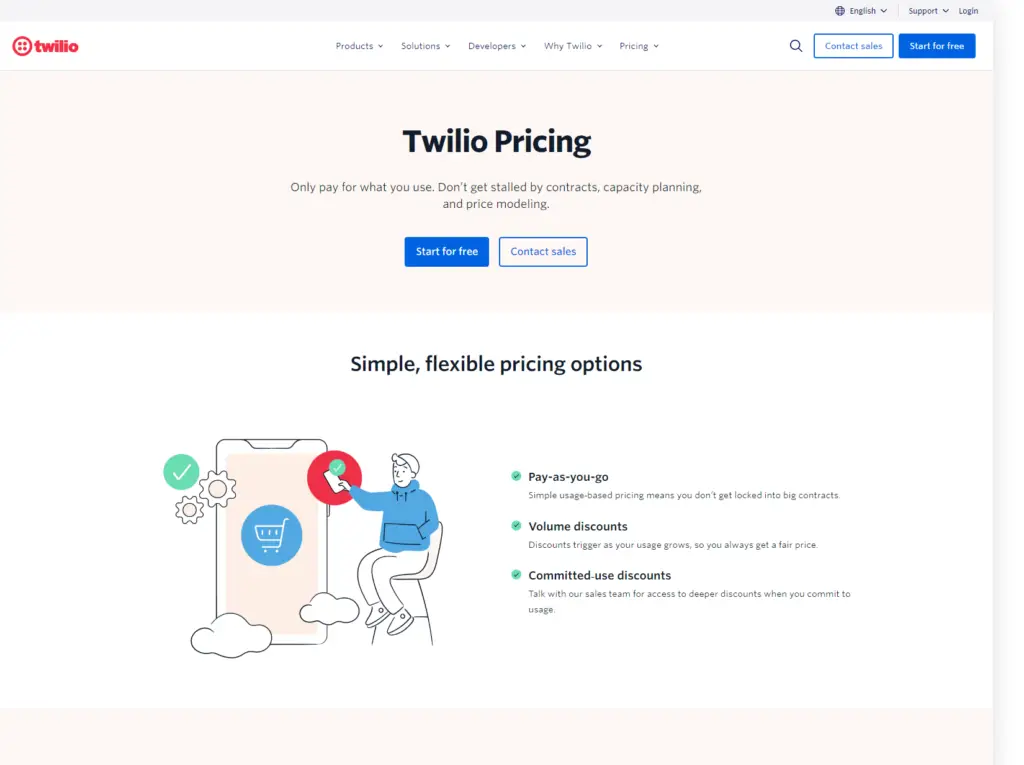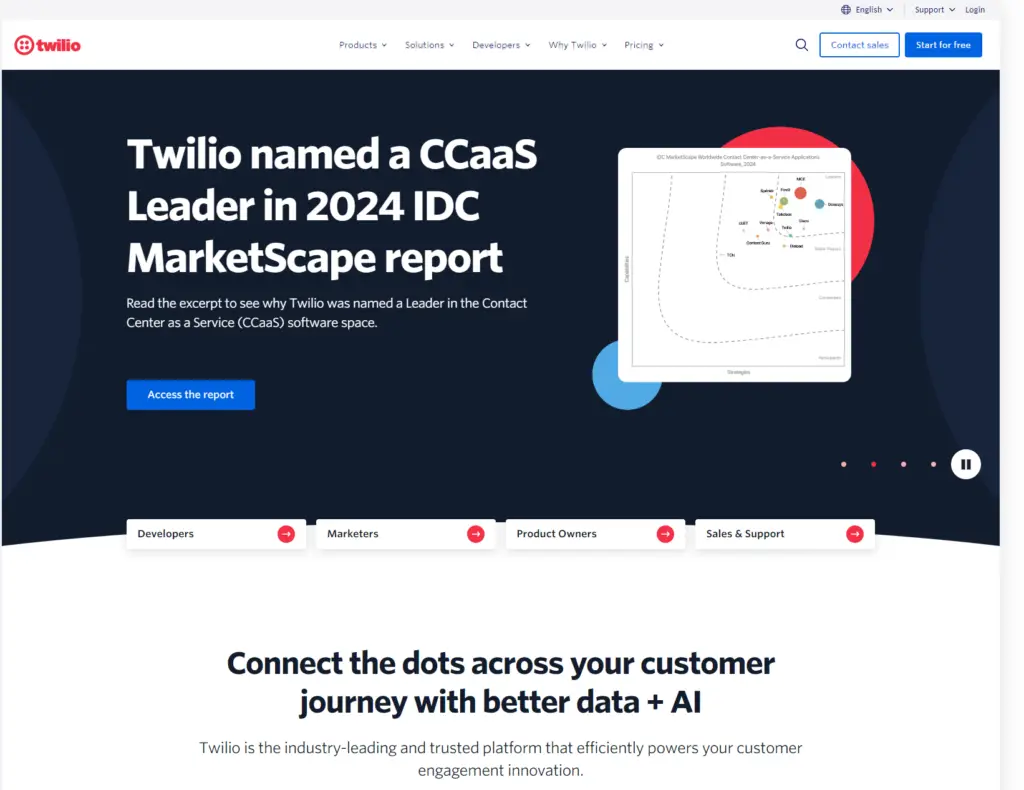In the modern digital landscape, efficient communication is the backbone of successful businesses. Twilio, a premier cloud communications platform, empowers companies to effortlessly engage with customers via SMS, voice, video, and chat. This Twilio software review provides a comprehensive analysis of the platform’s features, performance, and the latest updates for 2024. By exploring Twilio’s advantages and potential limitations, this review aims to assist businesses in deciding if Twilio is the ideal solution to elevate their communication strategies in the year ahead.
1. What is Twilio?
Twilio is a cloud communications platform that provides developers with a wide array of tools to build and manage communication channels like SMS, voice, video, and chat applications. Founded in 2008 by Jeff Lawson, Evan Cooke, and John Wolthuis, Twilio has grown into a significant player in the tech industry, offering scalable and reliable communication solutions for businesses of all sizes.
Overview of Twilio as a Company
Twilio’s mission is to fuel the future of communications by enabling developers to innovate and integrate communication functionalities directly into their applications. The company is headquartered in San Francisco, California, and operates globally, serving thousands of businesses across various industries. Twilio’s infrastructure is built to be highly scalable and resilient, ensuring that it can handle the communication needs of both small startups and large enterprises.
Key Features of Twilio
– Twilio Messaging: Provides APIs for sending and receiving SMS and MMS messages, facilitating customer engagement through text messaging.
– Twilio Voice: Offers voice call capabilities with features such as programmable voice, call tracking, and call forwarding.
– Twilio Video: Enables video communication with APIs for embedding video chat into applications, enhancing remote collaboration and customer service.
– Twilio Flex: A customizable cloud contact center platform that allows businesses to create tailored customer service solutions.
– Twilio API: Comprehensive suite of APIs that allow seamless integration with other software and platforms, making it easy to add communication features to existing applications.
Industries and Use Cases for Twilio
Twilio’s versatility makes it an attractive solution across various industries. Here are some key sectors and how they leverage Twilio’s capabilities:
– E-commerce: Retailers use Twilio to send order confirmations, shipping notifications, and promotional messages to customers, enhancing the shopping experience.
– Healthcare: Medical institutions utilize Twilio for appointment reminders, telehealth services, and patient follow-ups, improving patient care and communication.
– Financial Services: Banks and financial services companies rely on Twilio for secure account alerts, transaction notifications, and customer support.
– Education: Educational institutions use Twilio to facilitate online learning, send class reminders, and provide real-time communication between students and teachers.
– Travel and Hospitality: Travel agencies and hotels use Twilio to manage reservations, send travel updates, and improve customer service through real-time communication.
2. Key Features of Twilio
Twilio offers a comprehensive suite of communication tools designed to enhance business operations and customer engagement. Each feature is built to integrate seamlessly with existing systems, providing flexibility and scalability.
Twilio Messaging
Twilio’s messaging capabilities include SMS, MMS, and chat functionalities, enabling businesses to communicate effectively with their customers across various channels. The SMS service allows for sending and receiving text messages globally, while MMS supports multimedia messaging, which includes images, videos, and audio files. Twilio’s chat API facilitates real-time messaging within web and mobile applications, providing a cohesive communication experience.
Twilio Voice
Twilio Voice offers robust VoIP (Voice over Internet Protocol) services, allowing businesses to make and receive phone calls over the Internet. This feature includes programmable voice, which enables developers to control call flow, implement interactive voice response (IVR) systems, and automate call handling. Call routing ensures that calls are directed to the appropriate department or agent, improving customer service efficiency. Additionally, call recording capabilities help businesses maintain quality control and comply with regulatory requirements.
Twilio Video
Twilio Video provides tools for embedding video communication into applications, supporting use cases such as remote consultations, virtual meetings, and online collaboration. The API integration allows developers to add video chat functionality with ease, ensuring a seamless user experience. Twilio Video supports high-quality, low-latency video connections, making it suitable for both personal and professional use.
Twilio Flex
Twilio Flex is a fully programmable cloud contact center platform that allows businesses to create customized customer service solutions. Unlike traditional contact centers, Twilio Flex offers complete flexibility in designing the user interface, integrating with existing CRMs, and customizing workflows. This adaptability ensures that businesses can tailor their contact centers to meet specific needs, improving both agent efficiency and customer satisfaction.
Twilio API
The core strength of Twilio lies in its extensive API offerings, which provide integration capabilities with various software and platforms. These APIs allow developers to embed Twilio’s communication features directly into their applications, enabling seamless interaction between different systems. This integration capability supports a wide range of use cases, from simple SMS notifications to complex multi-channel communication workflows.
Twilio’s key features are designed to enhance communication, improve operational efficiency, and provide a better customer experience. By leveraging these tools, businesses can streamline their communication processes and stay ahead in the competitive market.
3. Twilio Software Review 2024: What’s New?
Twilio’s 2024 updates bring a range of enhancements aimed at improving performance and user experience. The platform now supports richer media formats in MMS, allowing for higher-quality images, longer videos, and interactive elements, boosting customer engagement.
Advanced AI and machine learning features have been integrated across Twilio’s services. These include smarter chatbots for customer service and improved voice recognition in Twilio Voice, enabling more efficient and personalized interactions.
Twilio Video now offers ultra-low latency streaming, essential for real-time communication in telehealth and virtual events. The video API has also been optimized for better mobile performance.
Twilio Flex, the cloud contact center, has been upgraded with enhanced workforce management tools and real-time analytics, helping businesses optimize agent performance and service quality.
User interface changes include a cleaner, more intuitive dashboard with enhanced customization options, making navigation easier and reducing the learning curve for new users.
Security has been bolstered with better encryption and compliance with global data protection regulations, ensuring customer data remains secure.
4. Twilio Pricing and Plans

Twilio’s pricing is flexible and scalable, designed to suit businesses of all sizes. Operating on a pay-as-you-go model, Twilio allows companies to pay only for the services they use, making it cost-effective for startups and small businesses by eliminating large upfront costs.
For messaging services, Twilio charges per SMS or MMS sent and received, with rates varying by the destination country. This precise pricing helps businesses manage their communication costs effectively.
Voice services are billed based on call duration and destination, with additional features like call recording available at extra costs. This allows businesses to customize their voice services according to their needs, from basic call handling to advanced functionalities.
Twilio Video charges are based on participant minutes, ideal for applications with varying video usage levels, from occasional calls to continuous conferencing.
Twilio Flex, the cloud contact center, offers two pricing options: a named user plan with a flat rate per agent per month, and an hourly plan billing based on actual usage. This flexibility helps businesses choose the most cost-effective option based on their operational patterns.
Additionally, Twilio provides volume discounts for high usage, reducing costs for large-scale operations.
5. Pros and Cons of Using Twilio
Twilio is a powerful cloud communications platform that offers numerous advantages for businesses, but it also has some drawbacks. Here’s a detailed look at the pros and cons, along with a comparison to other similar platforms.
Advantages of Using Twilio
1. Comprehensive Communication Solutions: Twilio provides a wide range of communication tools, including SMS, MMS, voice, video, and chat capabilities. This comprehensive suite allows businesses to manage all their communication needs within one platform.
2. Scalability: Twilio’s cloud-based infrastructure can scale effortlessly to accommodate growing business needs. Whether a small startup or a large enterprise, Twilio can handle varying levels of usage without compromising performance.
3. Flexibility and Customization: The platform’s extensive API offerings enable businesses to integrate Twilio’s services directly into their existing applications and workflows. This flexibility allows for high levels of customization to meet specific business requirements.
4. Global Reach: Twilio supports communication across a vast number of countries, making it suitable for businesses with international operations. The platform’s global carrier network ensures reliable messaging and calling services worldwide.
5. Pay-as-You-Go Pricing: Twilio’s pricing model allows businesses to pay only for what they use, which is particularly beneficial for startups and small businesses. This model helps manage costs effectively and eliminates the need for large upfront investments.
6. Innovative Features: Twilio continually updates its platform with new features and improvements. Recent additions like advanced AI and machine learning integrations, ultra-low latency video streaming, and enhanced security measures keep Twilio at the forefront of communication technology.
Potential Drawbacks or Limitations
1. Complexity for Beginners: While Twilio offers powerful tools, its extensive features and customization options can be overwhelming for users without technical expertise. Businesses might need dedicated developers to fully leverage Twilio’s capabilities.
2. Cost for High-Volume Users: Although Twilio’s pay-as-you-go model is cost-effective for many, businesses with very high communication volumes might find the costs adding up quickly. In such cases, negotiating volume discounts or exploring alternative pricing plans is necessary.
3. Dependence on Internet Connectivity: As a cloud-based service, Twilio’s performance heavily relies on Internet connectivity. Any issues with internet access can directly impact the quality and reliability of Twilio’s services.
4. Learning Curve: The broad range of services and APIs requires a learning curve. New users may need time to understand and effectively implement the various features Twilio offers.
Comparison with Other Communication Platforms
When compared to similar platforms like Nexmo (Vonage API), Plivo, and Bandwidth, Twilio stands out for its comprehensive feature set and robust global network. However, Nexmo is often praised for its simpler API and slightly lower messaging costs, making it a strong competitor for businesses primarily focused on SMS and voice services.
Plivo offers competitive pricing and strong support for SMS and voice services, but it lacks some of the advanced features and extensive customization options that Twilio provides. Bandwidth is known for its transparent pricing and control over phone numbers, appealing to businesses looking for straightforward telephony solutions.
6. User Feedback and Reviews
Twilio has garnered a significant amount of user feedback and reviews from various trusted sources, reflecting its impact and reliability as a communication platform. Overall, Twilio is highly rated for its extensive features, scalability, and flexibility, though some users have noted areas where improvements can be made.
Summary of User Reviews and Ratings
On popular review platforms like G2, and Capterra, Twilio consistently receives high ratings, often averaging between 4 to 4.5 stars out of 5. Users frequently highlight the platform’s comprehensive suite of communication tools and robust APIs that enable seamless integration with existing systems. The ability to scale effortlessly and handle large volumes of messages and calls is another commonly praised aspect.
Common Praises
One of the most frequent points of praise is Twilio’s reliability and uptime. Users appreciate the platform’s consistent performance and the minimal downtime experienced, which is crucial for business operations. The global reach of Twilio’s services is another highlighted advantage, with many users noting the ease of managing international communications.
Flexibility and customization options receive considerable commendation. Businesses value the ability to tailor Twilio’s services to their specific needs through its extensive APIs. This level of customization is particularly beneficial for companies with unique communication workflows.
Customer support is also mentioned positively in many reviews. Users report that Twilio’s support team is responsive and helpful, providing timely assistance and effective solutions to technical issues.
Common Complaints
Despite the many positives, there are common areas of criticism. A significant number of users point out the steep learning curve associated with Twilio. For those without technical expertise, the platform’s extensive features and customization options can be daunting. Businesses often need to allocate resources to understand and implement Twilio’s services fully.
Cost is another area where some users express concern. While the pay-as-you-go model is advantageous for many, businesses with high communication volumes may find the expenses adding up quickly. This has led some users to seek alternative solutions or negotiate for volume discounts.
Additionally, some users have reported occasional issues with SMS deliverability and voice call quality. Although these issues are not widespread, they highlight the importance of having reliable internet connectivity and a robust infrastructure to support Twilio’s services.
Overall Customer Satisfaction
In general, customer satisfaction with Twilio is high. The platform’s ability to provide a comprehensive and scalable communication solution is a significant draw for businesses of all sizes. The majority of users find that Twilio’s benefits, such as its extensive features, customization options, and reliable performance, outweigh the drawbacks.
However, the complexity of the platform and the potential costs for high usage are notable considerations. Businesses that are willing to invest in understanding Twilio and managing their usage effectively tend to have the most positive experiences.

